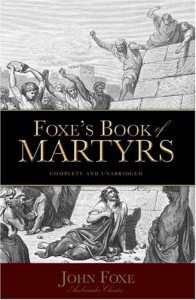Anne Askew: Mother, Minister, Martyr
A hot day in July 1546 was about to get hotter for Anne Askew, who was tied to a bundle of sticks between two similarly restrained friends. Her jailers had secured the wood to her mid-section because she’d been tortured to the point where she could no longer hold herself upright. Anne was the married mother of two young children. She was twenty-five years old and was about to be burnt to death for her faith.
Burning of Anne Askew
Anne was born to an up-and-coming gentry family in Lincolnshire. At the age of fifteen, she was forced to marry her dead sister’s fiancé, a not-unusual arrangement. She and her new husband, Thomas, did not get along well, partly because Anne was fervent and active in the budding English Reformation. The Dictionary of National Biography says she left her family to go “gospelling,” the sixteenth-century word most often used for preaching scripture.
This, of course, was unusual in a time when, by law, women were not only under the constant legal authority of their husbands but were also forbidden from reading the Bible aloud to any but their close friends in private. But it was not preaching that so offended the council of Henry VIII; it was Anne’s stubborn refusal to accept the doctrine of transubstantiation.
This doctrine, an important one in the Roman Catholic faith then and now, states that during Mass, now also known as Communion, or the Lord's Supper, depending on your tradition, the bread and wine become the actual body of Christ. Many reformers, such as Askew, believed that the elements were representative instead. Although it seems like a “live and let live” issue to us in the twenty-first century, at that time, according to Henry’s laws, the belief was heresy and punishable by death.
Anne was caught in the middle of the maelstrom, religion in the Tudor Court. Religious traditionalists wanted a return to the Roman Catholic faith, which had been foundational in England for over a thousand years. Reformers wanted change in the church or perhaps to establish a new church altogether.
Although many on both sides had deeply held convictions for which they lived and died, others were more interested in the temporal power of the final decision. Henry, sick, seemed to lean more and more upon his sixth wife, Queen Katherine Parr, a strong reformer. After her husband’s death, she hoped to continue influencing her stepson, Edward. Religious conservatives wanted Edward under their control. By implicating Parr through her friend Askew’s heresy, they hoped to bring down the queen, too. Anne has the dubious honor of being the first woman tortured on the notorious rack in the Tower of London. She was brought before it and asked to name other highborn women in the queen’s household who believed as she did, the implication being that the Queen should be named, too. When she refused, she was stripped of her clothing down to her shift and racked - a means of torture in which ankles and wrists are strapped to a pulley that stretches until all joints are dislocated. Afterward, Askew was brought to the stake in a chair.
After the fire was lit, Anne continued to correct the bible teaching of Bishop Nicolas Shaxton, so recently a friend and fellow reformer, till he recanted when faced with torture and death. She’d speak out as the flames rose, correcting Shaxton’s scripture. “Yes, he’s got that right,” she’d boldly call out on a passage, or “No, there he misseth and speaks without the book.”
John Foxe, the author of Foxe’s Book of Martyrs, tells us that someone provided gunpowder to be added to the stakes below Askew to speed up her death and quickly ease her pain. Many believe that the same strong women at court she protected - the Queen and her highborn ladies in waiting - supplied that gunpowder to speed the bold and courageous Askew heavenward on her “chariot of fire.”
{Burning of Anne Askew photo credit: By Robert Crowley, Public Domain, https://commons.wikimedia.org/w/index.php?curid=29730558 }



